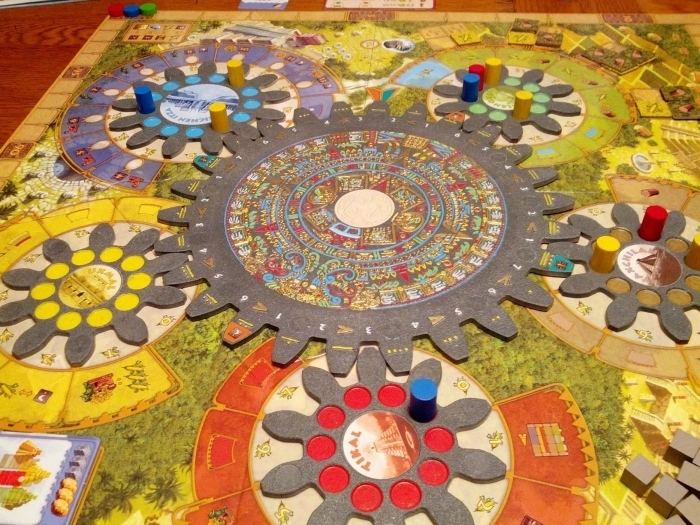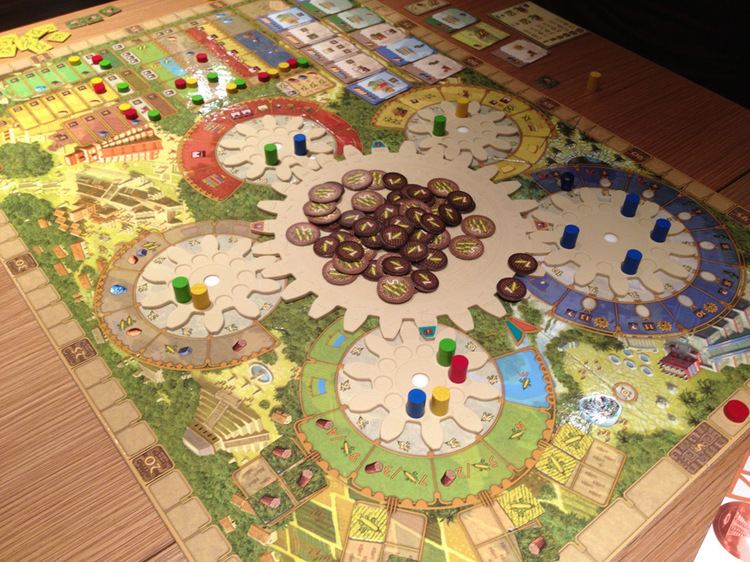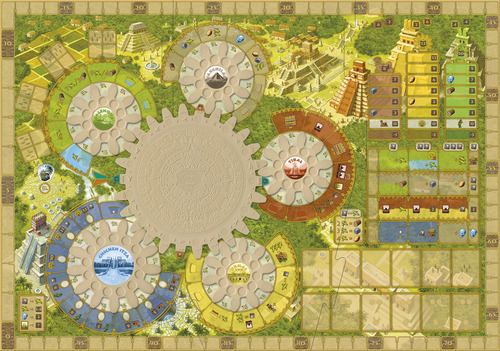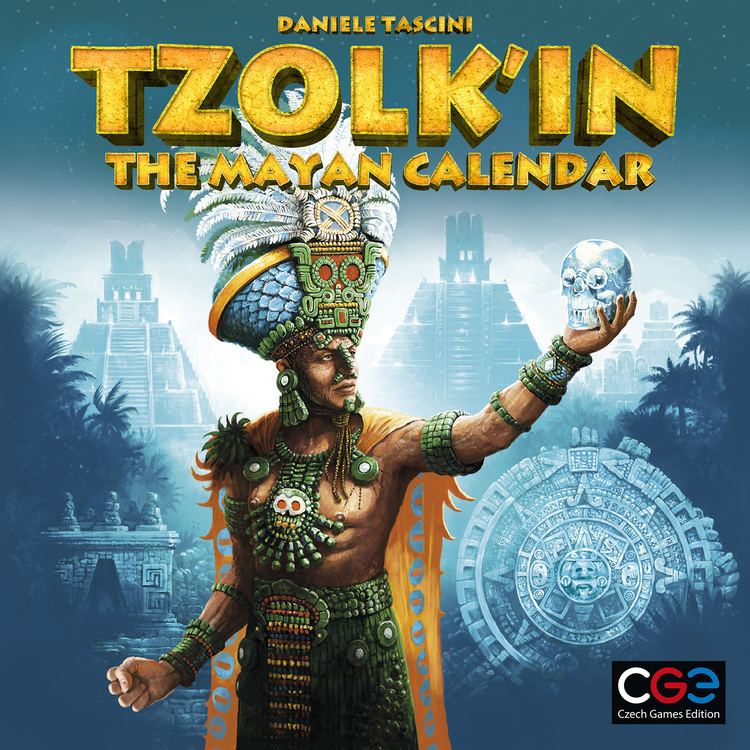 | ||
Tzolk in the mayan calendar gameplay runthrough
Tzolk'in ([t͡sol ˈkʼin], formerly and commonly tzolkin) is the name bestowed by Mayanists on the 260-day Mesoamerican calendar originated by the Maya civilization of pre-Columbian Mesoamerica.
Contents
- Tzolk in the mayan calendar gameplay runthrough
- Tzolk in full rules video
- The twenty day names
- Uses
- Origins
- The tzolkin and the New Age movement
- References

The tzolk'in, the basic cycle of the Maya calendar, is a preeminent component in the society and rituals of the ancient and the modern Maya. The tzolk'in is still in use by several Maya communities in the Guatemalan highlands. Its use is marginal but spreading in this region, although opposition from Evangelical Christian converts continues in some communities.

The word tzolk'in, meaning "division of days", is a western coinage in Yukatek Maya. There are various terms in actual use in the languages of Maya groups who have maintained an unbroken count for over 500 years: The K'iche' use the term Aj Ilabal Qʼij [aχ ilaɓal ʠiχ] or Rajilabal Kʼij [ɾaχ ilaɓal ʠiχ], 'the sense of the day' or 'the round of the days' and the Kaqchikel use the term Chol Qʼij [tʃol ʠiχ], 'the organization of time'. The names of this calendar as used by the pre-Columbian Maya are not widely known. The corresponding Postclassic Aztec calendar, was called tonalpohualli, in the Nahuatl language.

Tzolk in full rules video
The twenty day names

The tzolk'in calendar combines a cycle of twenty named days with another cycle of thirteen numbers (the trecena), to produce 260 unique days (20 × 13 = 260). Each successive named day is numbered from 1 to 13 and then starting again at 1. There are 20 individual named days:

The tzolk'in does not have a generally recognized start and end, although there are specific references in the books of Chilam Balam to 1 Imix as the beginning day.
Each of the twenty days has its specific primary association connected to the day name's meaning.

The variant names and associations below are common to three post-conquest Guatemalan highland calendars, whose interpretations are based primarily on an 1854 manuscript by Hernandez Spina.
Uses
The tzolk'in was extensively used in Mayan inscriptions and codices. Symbolism related to the tzolk'in is also observed in the Popol Vuh (which, though written in the early post-conquest period, is probably based on older texts). For instance, when Ixbalanque has set an impossible task for Ix Quic of collecting a netful of corn from one stalk and Ix Quic successfully completes it, she leaves the imprint of her net in the ground, and the day "net" is the opening of the Venus cycle which follows "ahau" ("ajpu" in K'iche'), just as her child is the heir of Hun Hunajpu.
The uses to which the ancient Maya applied the calendar are unknown, nonetheless modern Maya communities employ the calendar as follows:
Origins
The 260-day calendar spread throughout the Mesoamerican cultural region and is regarded as the oldest and most important of the calendar systems, with an origin predating its first appearances in Maya inscriptions. The earliest evidence of this calendar comes from a possible day sign with a dot numeral coefficient in an Olmec-like inscription in Oxtotitlán cave dated to 800-500 BCE. Some of the next oldest calendric inscriptions are from early strata of Zapotec in the Oaxacan highlands at sites such as Monte Albán, dating from mid-1st millennium BCE. A few earlier-dated inscriptions and artifacts have what appear to be calendric glyphs, such as at San José Mogote and in the Olmec Gulf Coast region. However, either the dating method or the calendric nature of the glyphs are disputed by scholars.
The original purpose of such a calendar, with no obvious relation to any astronomical or geophysical cycle, is not securely known, but there are several theories. One theory is that the calendar came from mathematical operations based on the numbers thirteen and twenty, which were important numbers to the Maya, (Thompson 1950: Maya Hieroglyphic Writing:Introduction). The number twenty was the basis of the Maya counting system, taken from the total number of human digits. (See Maya numerals). Thirteen symbolized the number of levels in the Upperworld where the gods lived, and is also cited by modern daykeepers as the number of "joints" in the human body (ankles, knees, hips, shoulders, elbows, wrists, and neck). The numbers multiplied together equal 260.
Barbara Tedlock, studied this system in the contemporary K'iche Maya community of the municipality of Momostenango in highland Guatemala. She underwent a formal apprenticeship in calendar divination with a local adept, and was initiated as a diviner in 1976. She says: "The Momostecan calendar embraces both the 260-day cycle and the 365-day solar year, with the four Classic Maya Year-bearers, or Mam, systematically linking the two. The 260-day cycle is conceived as linked firmly to worldly or earthly affairs, mirroring no astronomical period but rather the period of human gestation. Past ethnographic accounts of this cycle contain various conflicting opinions as to what its first day is, but a comparison of the present results and those of previous studies indicates that there is no fixed first day."
Anthony Aveni asserts, "Once a Maya genius may have recognized that somewhere deep within the calendar system lay the miraculous union, the magical crossing point of a host of time cycles: 9 moons, 13 times 20, a birth cycle, a planting cycle, a Venus cycle, a sun cycle, an eclipse cycle. The number 260 was tailor made for the Maya". Others have observed that the "Venus Table" in the Dresden Codex, is an accurate ephemeris for predicting Venus positions. Others have also observed a basis for the 260-day cycle in the agricultural cycle of highland Guatemala, which is also about 260 days. Aveni notes that "the average duration between successive halves of the eclipse season, at 173 ½ days, fits into the tzolkin in the ratio of 3 to 2." This may seem contrived, but the Maya did employ the tzolkin to predict positions of Venus and eclipses.
Another theory is that the 260-day period is the length of human pregnancy. This is close to the average number of days between the first missed menstrual period and birth, unlike Naegele's rule which is 40 weeks (280 days) between the last menstrual period and birth. It is postulated that midwives originally developed the calendar to predict babies' expected birth dates.
Vincent Malmström identifies a correlation between the 260-day cycle and the 260-day gap between zenithal passages of the sun. According to this hypothesis, the 260-day cycle originated in the narrow latitudinal band (14°42′N to 15°N) in which the sun is vertically overhead about 12–13 August and again 260 days later about 30 April – 1 May (Malmström identifies the proto-Classic Izapan culture as one suitable candidate at this latitude). This period may have been used for the planting schedule of maize. However, others object to this conception, noting that while the 260-day calendar runs continuously the interval between autumn-spring and spring-autumn positions alternates between 260 and 105 days, and that the earliest-known calendric inscriptions are from considerably further north of this zone. Consequently, this theory is not widely supported.
It is also possible that the number 260 has multiple sources.
The tzolk'in and the New Age movement
The tzolk'in is the basis for the modern, New Age invention of the "Dreamspell" calendar, developed by the esoteric author José Argüelles. The Dreamspell calendar is sometimes mistakenly identified as an authentic interpretation or extension of the original Maya calendar, although Argüelles himself acknowledges the Dreamspell calendar is a new and syncretic creation, inspired by elements from Mesoamerican and non-Mesoamerican sources.
In 1987, before the Harmonic Convergence, inspired by a single paragraph of Argüelles's book "The Mayan Factor" (wherein he refers to each day as a "tone"), singer/songwriter and sound healer, Alyras (aka Mirai), translated the tzolk'in's harmonic values into sound, with the tutelage of Barbara Hero. Eschewing extensions of the tzolk'in, Alyras opted for strict mathematical adherence to the tzolk'in's fundamental structure and sequences, in order to present a truly authentic sonic expression of its inner workings.
In 1995, Maria von Boisse translated the mathematical matrix of the tzolk'in to musical notes and set them into music. The final version of the work was developed in collaboration with Hubert Bognermayr in the Electronic Försterhaus in Linz, Austria.
